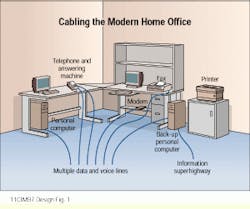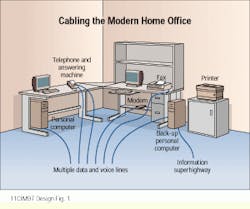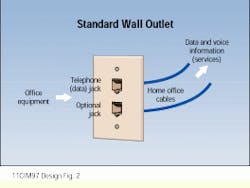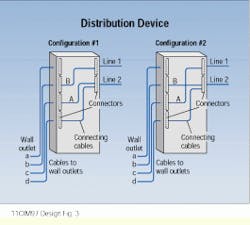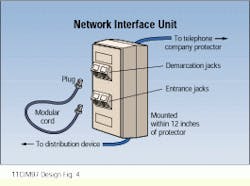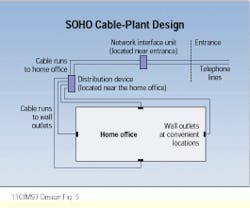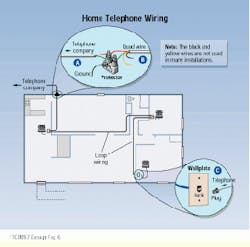Designing telecommunications for small offices and home offices
As we prepare to enter the twenty-first century, our residential and light-commercial cabling must be brought up to par with the sophisticated electronic and telecommunications equipment we acquire for business and entertainment.
Ernest F. Brosch,
Cable Engineering Services
Not too many years ago, the telephone was a fixture in the home, like the refrigerator or range. As was the case with other appliances, the telephone was delivered by a serviceperson from the local phone company, who advised where it should be placed and then did the installation.
Times, however, have changed, and what was once a simple and inexpensive procedure is now a bit more complicated and costly. First came the demand for several telephones spread throughout the residence, followed by the need in many cases for a second telephone line or number. While talkative teenagers have been given much of the credit for these changes, additional telephone lines are regularly installed to residences for business purposes as well. The residential telephone has become more than an instrument for emergencies or socializing; it is now at the center of the home office.
Home offices are becoming so prevalent that they have generated their own technical term in the telecommunications industry, complete with acronym--small office/home office (soho), also sometimes abbreviated sohot, with the addition of "telecommuting" at the end of the phrase.
It has been easy enough to bring office equipment--such as personal computers, modems, answering machines, fax machines, and printers--into the home. Luckily, most modern office machinery requires little electrical power, and it is usually compact enough to fit comfortably into a limited space.
However, the cabling and connections linking the home office to the public telephone network have not until recently been widely available in the residential marketplace, creating a bottleneck for telecommuters. In addition, connecting to the telephone system is no longer the simple matter of hooking up a single voice line. Today`s multiple voice and data lines require performance beyond that which the present method of cabling, called loop wiring, can provide. Continuing to use this wiring scheme will very soon seriously affect the capabilities of a home-based business in a marketplace that demands increasingly higher speed and greater volume in its communications.
Design is key
The key to successfully designing the modern home office lies in the telecommunications cabling, which is the transport vehicle that links home-office business equipment to the rest of the business world. The designer`s main goal is to provide flexibility in the cable network, so it will meet business needs both today and in the future.
To achieve this flexibility, first plan the locations of the wall outlets that will provide a place for office equipment to attach to the cable network. The outlets chosen should conform to telecommunications-industry standards and must provide interfaces for both data and voice connections, or service.
The primary design considerations in placing the wall outlets are
- to provide a sufficient number of outlets to handle future needs--for example, by placing one outlet on each wall of the office;
- to arrange the outlets so that the office can be reorganized without rewiring;
- to supply interchangeable services at each outlet, so that the cables that interconnect computers can be the same as those that connect computers to modems and serial printers.
The best way to permit services changes at the outlet is to build a distribution device into the network. About the size of a cigarette carton, the distribution device can be mounted on a wall or in a closet. Functioning as a miniature patch panel, the device lets the cables running to wall outlets be disconnected and reconnected in any configuration desired. Consequently, all home- office telecommunications cables run to this central point.
In addition to simplifying and speeding up service changes, the distribution device also makes isolating failures easier and quicker, because cables can be disconnected at the device and tested individually. If the distribution device can be located in or near the home office, the length of cables running to the wall outlets can be greatly reduced, and troubleshooting can be performed more quickly, since the time taken to go from one end of the cable to the other while testing is reduced.
An additional piece of hardware needed for the home office is a network interface unit (niu), which should be mounted near the entrance. This device is similar in size to a wall outlet, and can be used to mount a number of telephone jacks. The niu should have entrance and demarcation telephone jacks for each telephone line. The two types of jacks are connected by a removable modular patch cord, which allows you to disconnect home-office telephone lines from the telephone company.
There are two reasons for installing a network interface unit:
- It lets you disconnect the line from the telephone company whenever you make changes at the distribution device. This is an important consideration because the voltage on the line, used to ring the telephone, can pose a shock hazard. In addition, accidentally shorting wires can damage sensitive electronic equipment.
- Isolating the home-office cable network from the telephone line makes it easier to locate faults, letting you determine if a failure is in the home office or caused by the telephone company. This is important because the telephone company will charge for service if called in to repair a fault in the customer`s network.
The traditional loop-wired residential telephone installation has offered many advantages over the years. Little planning is required, the components making up the system are found in most hardware and electrical-supply stores, and technicians trained in this type of installation abound. However, because this system was designed and built for voice transmission, its capability is limited to one telephone line intended primarily for personal use.
Loop wiring may need to be replaced by the kind of system described here because one telephone line is usually not adequate to serve both personal and business purposes in the home. The duplication of wiring required by multiple loops, the lack of flexibility in such a system, and the limited transmission capability of this technology will all push the residential marketplace to higher-speed home networks capable of handling both the voice and data to be found on our emerging Information Superhighway.
Caution!
The inexperienced homeowner should not attempt to work on a loop-wired telephone system. Such a system typically cannot be safely disconnected from the telephone company line, so it always presents the possibility of an electrical-shock hazard to the do-it-yourselfer who is adding or moving telephone cables.
Cabling a home office requires more lines and higher capability per line than has been the case with residential telephone wiring in the recent past.
The home-office wall outlet should conform to industry standards and must provide links for both voice and data service.
A distribution device lets cables be connected to different pieces of office equipment. In configuration #1, for example, telephone line 1 is connected to wall outlets a and b, and line 2 is connected to outlets c and d. By moving connecting cables A and B in the distribution device, line 1 can be connected to outlets a and c, while line 2 is connected to b and d.
The network interface unit, located near the entrance, provides entrance and demarcation jacks that can be interconnected using modular cords.
The overall cable design for a home office or small office includes a network interface unit near the entrance, a distribution device in or near the office, and wall outlets at convenient locations in the office.
Plain old telephone service
Telephone service to the residence has changed little over the years. Typically, in what is humorously known as "plain old telephone service" (pots), a single incoming line from the telephone company is wired in a loop to a number of telephone outlets in the home.
The point where the line from the telephone company enters the home is called the entrance. It is at this point that the homeowner`s responsibility for the resid- ential telecommunications system begins. So moves, additions, changes, and service performed inside the entrance are at the expense of the homeowner and are not the responsibility of the telephone company.
The components of a loop-wired circuit are the protector, quad wire, and wallplates.
- The protector, installed and owned by the telephone company, is designed to protect both ends of the telephone line from high-voltage surges such as those caused by lightning strikes. Mounted at the entrance, the protector may be found in a box on the outside of the house or near the AC power panel. Protectors come in various shapes and sizes, but are usually about the size of a cigarette pack.
- Quad wire, as its name implies, consists of four copper conductors, each of which is insulated in a different color--red, green, black, and yellow. This cable connects the protector to the wallplate, and runs from wallplate to wallplate.
- Each residential telephone is connected to an outlet mounted in a wallplate. The outlet takes the form of a jack, into which a plug is inserted to establish electrical contact for each of the four conductors in the quad wire. Behind the wallplate, a small connecting block holds four connecting screws used to join the quad wire running through the wall to the jack.
Adding a second telephone line in a residence calls for a second protector, as well as another loop of quad wire connecting the telephones using the other line.
The home telephone wiring found in most residences today consists of three components: a protector, quad wire, and wallplates into which individual telephones are plugged. If a second telephone line is needed a second protector and a redundant loop of quad wire must be added.
Ernest F. Brosch, professional engineer, is the principal for Cable Engineering Services (Shorewood, MN), and author of How to Cable the Home Office/Small Office: A Complete Guide, published by Flatiron Publishing (New York). Brosch can be reached at (612) 474-2372, the publisher at (212) 691-8215, fax: (212) 691-1191.
